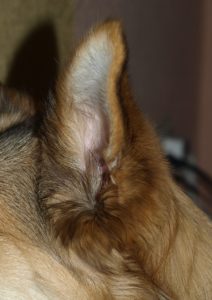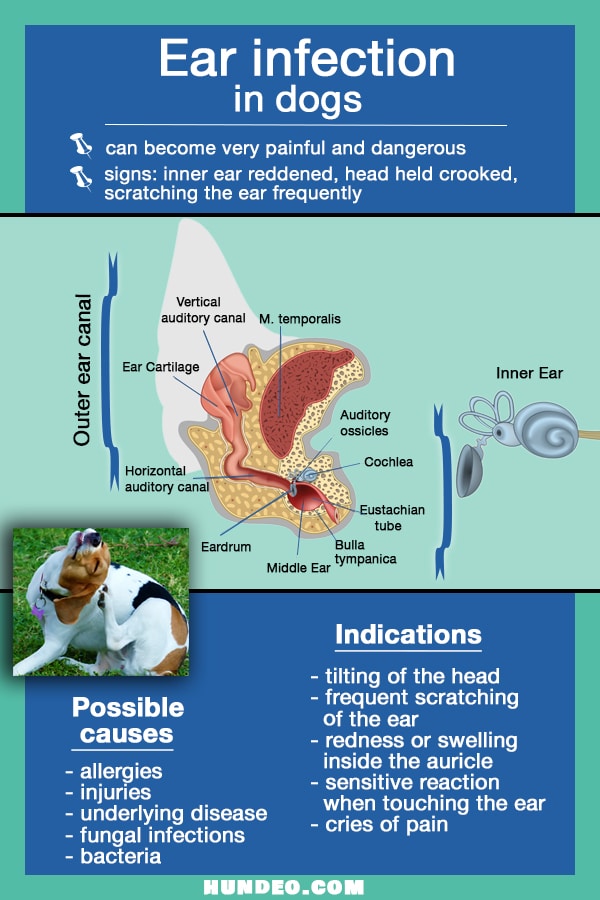Dog Ear Infection? (5 important tips)
- Veterinarian Mag.med.vet. Emin Jasarevic
- Updated: 2023-04-12
An ear infection in dogs can be dangerous and painful. You should at least know the signs and possible causes of it. I'll show you everything you need to know in this article. Also, for this article we have chosen Advice from veterinarian Mag.med.vet. Emin Jasarevic obtained. Note: This article is written for the german country.

What is an ear infection?
Ear infections are common in dogs. It can be very painful for your pet. Besides, it can become very dangerous if not treated in time.
Inflammations can occur in different areas of the ear and show themselves in different manifestations. As a rule, there is not only one cause for their occurrence. There are usually several factors at play here.
If your four-legged friend holds his head crooked, scratches his ear frequently or the inside of the ear is reddened, you should observe him more closely. This can be a sign of an ear infection in the early stages.
If you respond quickly and take the right measures, you can save your charge a lot of pain and unpleasant complications.
The structure of the Hundeohres

The ear of your furry nose consists of the outer ear, the eardrum, the middle ear and the inner ear. Inflammations mostly affect the outer ear or the middle ear. In severe cases, the inner ear may also be inflamed.
A dog's ear has an ear canal that is between 5 and 10 cm long, depending on the breed. This makes it much longer than that of humans. The canal first goes down almost vertically, then continues in an L-shape horizontally to the eardrum.
Behind it are the middle ear and the inner ear, and the organ of balance is also located here. The ear canal is enclosed by cartilage. On the cartilaginous skin sit many glands that are responsible for the production of earwax.
In some quadrupeds, hair also grows inside the auricle. This can increase the susceptibility to inflammation.
Why does a dog get an ear infection?
Several factors usually play a role in inflammation of the ear.
Bacteria can spread in the ear canal due to allergies, injuries, another underlying disease or fungal infections. There they then cause an inflammation.
If your pet has an ear infection, it will be very painful and uncomfortable for him, especially if it is also accompanied by itching.
Some furbearers are more often affected by inflammation in the ear. These are mainly dogs with floppy ears, who go in the water a lot or who have allergies.
Is an ear infection dangerous?
The deeper the inflammation in the ear progresses, the more dangerous it can become.
The inner ear is very close to the brain and the facial nerve. There is a risk of bacteria entering these areas. This condition can be life threatening for your faithful companion. Among other things, he may suffer as a result of a Meningitis suffer.
Even if it is "only" an inflammation of the outer ear or the middle ear, the suffering is very great. In addition, there is a risk of permanent damage such as Tympanic membrane injuries, Hearing loss and Violation of the organ of equilibrium.
Bacteria and allergies as a cause of ear infection
For the ear infection in your dog, there are usually several causes that favor the development of inflammation in the first place.
Inflammation in the ear, like all other inflammations, is caused by bacteria. But usually other certain conditions are necessary for bacteria or fungi to settle and expand.
A common cause of ear infection in dogs are Allergies. The reason is that dogs detoxify through the ears. Whenever the detoxification organs such as kidney and liver are weakened and an allergic reaction or intolerance persists, this can be done through the ears.
Thus, chronic ear infections often go hand in hand with kidney or liver weakness, diseases of the digestive system or metabolic disorders. The organism is then simply weakened overall.
Triggers for an allergy can be ingredients of the food, house dust, pollen or other allergens that are not always easy to identify.
Certain systemic diseases and autoimmune diseases can also be accompanied by ear inflammation. The weakening of the organism then makes itself felt through the chronic inflammation of the ear.
Fungi and mites in ear infection

Very many ear infections show, in addition to the occurrence with bacteria, a colonization of the ear with Mites or yeast fungi on. Here, the infestation and the inflammation are mutually dependent.
Aggravating for the dog, the mites or yeast fungi often causes an annoying and painful Itching on. The scratching can cause your pet to develop additional small Wounds in the auricle emerge, which will Inflammation strengthen.
It is also possible for mites and yeast to spread to other parts of the body, such as the paws and muzzle, causing uncomfortable itching.
Other possible causes

A less common cause of an ear infection may also be a Bite injury be. If your pet has been bitten in the ear, the wound on or in the ear may become infected as a result.
If ear infections occur more frequently, the Ear shape also play a role:
Take a look at the shape of your pet's ears. Quadruped with Floppy Ears, in which many hairs also still grow in the inner area of the ear, are naturally much more susceptible to ear infections. The ears are simply not as well ventilated as pricked ears, and accordingly bacteria, fungi and mites have an easier time there.
Especially for breeds with many hairs on and in the ears there is also a risk that when walking in the meadow. Pollen and Awns attach themselves to the hair and penetrate into the ear. Here, they can then literally embed themselves in the skin and possibly cause inflammation.
When your darling often swim goes, inflammation can also occur due to the penetration of water into the ear.
How to recognize an ear infection!
Ear infections in dogs are relatively easy for you to recognize as an attentive dog owner.
The pain that occurs will usually draw your dog's attention. Regardless of the cause of the inflammation, the following main symptoms can be seen:
- Keeping the head crooked
- Frequent head shaking
- Frequent scratching of the ear
- Redness or swelling in the inner area of the auricle
- Sensitive reaction to touching the ear such as sounds of pain, aggressive behavior
The symptoms also depend on which part of the ear is inflamed in your protégé. In addition, the causes and accompanying circumstances of the inflammation also play a role.
Inflammation of the outer, middle or inner ear
If the outside of the ear or pinna is affected, you can recognize this by the reddened and possibly also swollen cartilaginous skin inside.
The more the ear canal and the middle or inner ear are affected, the greater the suffering for your furry nose.
A Otitis media can threaten the eardrum, and often also goes with Fever and very severe pain here.
It becomes very critical when the inner ear is affected. Then the inflammation can spread to the facial nerve or even to the brain. Hemiplegia of the face may occur. The eye on the affected side is sometimes watery and swollen.
Should the brain be affected by the ear infection, it can lead to Changes of character and Aggression come.
. Mites and Yeast fungi belong to the Concomitants of ear infections.
You can recognize mites by brown, crumbly secretions from your four-legged friend's ear. Among the yeasts, it is mainly the malassezia that occur frequently. Although they are part of the natural environment in the dog's ear, they can cause problems in connection with inflammation and when they occur en masse.
You can recognize infections with yeast fungi in the ear by a brown, waxy and bad-smelling secretion.
How to diagnose an ear infection
The symptoms your dog exhibits can help in making a diagnosis. If your pet has the symptoms described above, it is most likely an ear infection.
You can get an exact diagnosis for the cause of the ear infection through your veterinarian. He can make a Swab from the ear and determine which bacteria and yeast fungi are at work through laboratory testing.
Treatment options for ear infections
Treatment depends on the causes of the inflammation. Most often it is a complex of various factors.
First of all, it is a matter of Contain inflammation. This can be achieved by the administration of local or systemic antibiotics take place. So either by applying antibiotic ointment directly into the ear or by therapy with tablets.
But also with natural means such as Tea tree oil ointment or Coconut oil can prevent the spread of the bacteria. These preparations are then applied directly in the ear.
Please do not use natural remedies without first consulting your veterinarian or a veterinary practitioner. Most of the remedies are essential oils, which can have an unpleasant effect on your pet.
If an allergy is the reason for recurring ear infections, it is advisable that you contact the Trigger find out about your dog and eliminate them. In this case, it is also important to strengthen the functions of the liver and kidneys by administering appropriate preparations.
Of course, if there is an underlying disease or auto immune disease, it must be addressed in addition to the treatment of the ear infection.
Likewise, it is important to do something about mites and yeast fungi.
For this purpose, your veterinarian can administer appropriate preparations. However, you must be careful to administer them long enough so that the reproduction cycle is interrupted. Therefore, it is advisable to follow the prescription of your veterinarian exactly and not to stop the treatment prematurely after some signs of healing.
How can you properly prevent?
Ear infections are painful for your dog, very unpleasant and the treatment is often costly and lengthy. To ensure that your pelt nose is spared from them in the long term, you should take preventive measures. A few simple measures are sufficient, but you should carry them out regularly.
The care and cleaning of the ears belongs here in the first place. Look once a week in the ears of your favorite, and check them for inflammation, fungus or mite infestation.
Thereby you can directly also to the Vorbeuge something Coconut oil or tea tree oil ointment into the inside of the ear. This not only helps prevent bacterial infections, but is also a pleasant massage that stimulates blood flow and energy to the ear. Massaging the ears has an especially relaxing effect on your faithful companion.
Does your protégé like to swim? During and even after an ear infection, you should not let him in the water. If water enters the ear, it can worsen the inflammation or negatively affect the success of the therapy.
Make sure that no water gets into the ears when you wash your dog. To do this, hold your hand to his ear as a shield.
Moisture in the ear favors the climate that bacteria & co. need to thrive.
Should your protégé suffer from Allergies and Incompatibilities suffer, you must pay attention to it, to keep his food and environment free of allergens.
This may require a permanent change of food or variety in the diet. You can possibly consider BARF feeding, or try different types of food.
Always pay attention to high quality of the feed. It is also advisable to include compatible vegetables, herbs and high-quality oils in his diet. This way you will strengthen his whole organism and his immune system in the long run.

Frequently Asked Questions
If left untreated, an ear infection in dogs can lead to hearing damage and even meningitis. This can be fatal. If you notice an ear infection, you should definitely take your dog to the vet.
Bacteria and viruses are the main triggers for ear infections in dogs. But allergies and chronic kidney and metabolic diseases can also affect the ears. Mites and fungi can also play a role in the inflammation.
The first thing to do is to find out the reason for the inflammation. For this you need the help of a veterinarian. In any case, you should observe your dog very closely to be able to give your vet all the necessary information for the diagnosis. Then follow the instructions of your veterinarian exactly.
You should get everything your dog reacts to with allergies or intolerances out of his reach and make sure he doesn't get too much water in his ears. You should also check and clean his ears weekly.
The pain that occurs will usually draw your dog's attention. Regardless of the cause of the inflammation, the following main symptoms can be seen:
- Keeping the head crooked
- Frequent head shaking
- Frequent scratching of the ear
- Redness or swelling in the inner area of the auricle
- Sensitive reaction to touching the ear such as sounds of pain, aggressive behavior
Veterinarian’s Recommendation
If it does not help, the veterinarian is still always the first choice and can not replace any guide on the net.
An ear infection that is untreated or improperly treated can have very serious consequences for your dog. Your pet may suffer from hearing loss, meningitis or facial paralysis, among other things.

I am a veterinarian and writer on animal health topics. Animals are my passion, and it is my personal goal to create medically accurate articles and videos to educate pet owners as much as possible.
Share Now:
Related posts:

